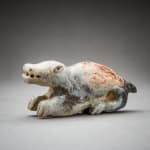Neolithic period dickite zoomorphic figurine, 5000 BCE - 4000 BCE
Dickite stone
4.3 x 10.2 cm
1 3/4 x 4 in
1 3/4 x 4 in
OF.135
Dickite is a clay mineral named after the metallurgical chemist Allan Brugh Dick, who first described it. It is chemically composed of 20.90% aluminium, 21.76% silicon, 1.56% hydrogen and 55.78%...
Dickite is a clay mineral named after the metallurgical chemist Allan Brugh Dick, who first described it. It is chemically composed of 20.90% aluminium, 21.76% silicon, 1.56% hydrogen and 55.78% oxygen. Dickite takes on the appearance of a white, brown earthy color and is often found embedded in many other minerals such as quartz, whereas it often contains impurities such as titanium, iron, magnesium, calcium, sodium and potassium.
in 1888, Allan Brugh Dick (1833–1926), a Scottish metallurgical chemist, was on the island of Anglesey to conduct research on kaolin. He performed various experiments describing the clay mineral, today known by his name. It was not until 1931 though that two other chemists Clarence S. Ross and Paul F. Kerr looked closer at the mineral and concluded that it was different from the known minerals of kaolinite and thus named it after him.
The Neolithic Age was a period in the development of human technology, beginning about 10,200 BC, in some parts of the Middle East, later in other parts of the world and ending between 4500 and 2000 BC.
Traditionally considered the last part of the Stone Age, the Neolithic period commenced with the beginning of farming, which produced the "Neolithic Revolution". It ended when metal tools became widespread in the Copper, Bronze or iron Age. The Neolithic is a progression of behavioral and cultural characteristics and changes, including the use of wild and domestic crops and of domesticated animals.
Unlike during the Paleolithic, only one human species (Homo sapiens sapiens) existed in the Neolithic.
The term Neolithic derives from the Greek ???? néos, "new" and ????? líthos, "stone", literally meaning "New Stone Age". The term was invented by Sir John Lubbock in 1865 as a refinement of the three-age system.
Intricate artefacts such as this crouching zoomorphic figurine have been recovered around the shores of Lake Van.
Lake Van is the largest lake in Turkey and lies in the far east of that country in the provinces of Van and Bitlis, in the highest and largest region of Turkey.
in 1888, Allan Brugh Dick (1833–1926), a Scottish metallurgical chemist, was on the island of Anglesey to conduct research on kaolin. He performed various experiments describing the clay mineral, today known by his name. It was not until 1931 though that two other chemists Clarence S. Ross and Paul F. Kerr looked closer at the mineral and concluded that it was different from the known minerals of kaolinite and thus named it after him.
The Neolithic Age was a period in the development of human technology, beginning about 10,200 BC, in some parts of the Middle East, later in other parts of the world and ending between 4500 and 2000 BC.
Traditionally considered the last part of the Stone Age, the Neolithic period commenced with the beginning of farming, which produced the "Neolithic Revolution". It ended when metal tools became widespread in the Copper, Bronze or iron Age. The Neolithic is a progression of behavioral and cultural characteristics and changes, including the use of wild and domestic crops and of domesticated animals.
Unlike during the Paleolithic, only one human species (Homo sapiens sapiens) existed in the Neolithic.
The term Neolithic derives from the Greek ???? néos, "new" and ????? líthos, "stone", literally meaning "New Stone Age". The term was invented by Sir John Lubbock in 1865 as a refinement of the three-age system.
Intricate artefacts such as this crouching zoomorphic figurine have been recovered around the shores of Lake Van.
Lake Van is the largest lake in Turkey and lies in the far east of that country in the provinces of Van and Bitlis, in the highest and largest region of Turkey.



